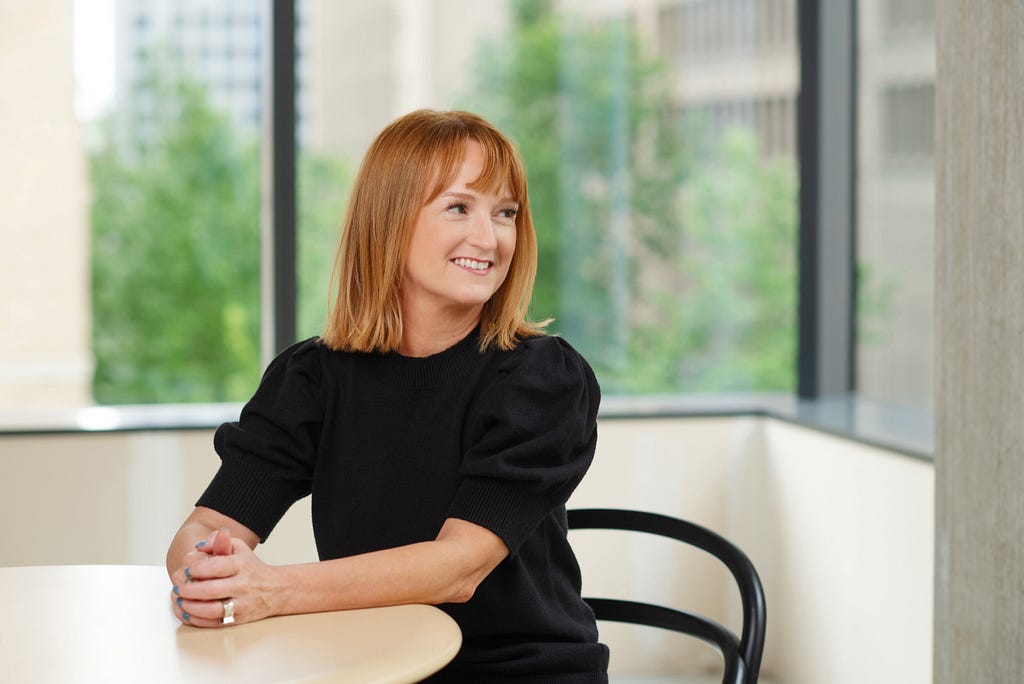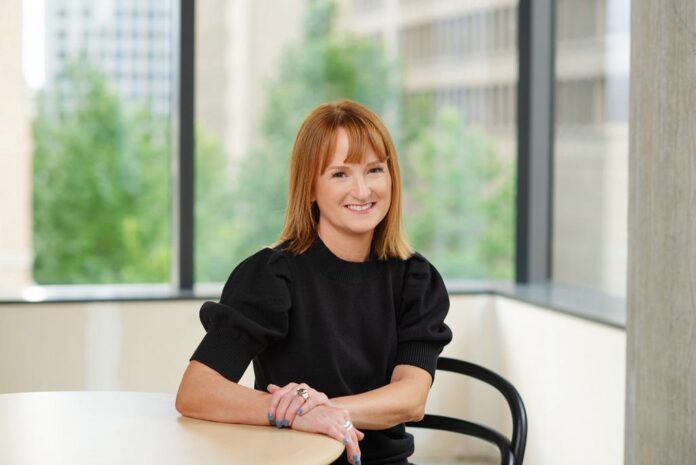Christa Jansen Of HKS: Five Things You Need To Create A Highly Successful Career As A Commercial Designer
An Interview With Athalia Monae
Stay curious and open-minded: Curiosity can lead to more thoughtful, human-centered designs. A successful career in commercial design starts with listening and understanding people’s needs, ideas and experiences.
As a part of my series about the ‘Five Things You Need To Know To Create A Highly Successful Career As A Commercial Designer,’ I had the pleasure of interviewing Christa Jansen, principal and regional design director of interiors at HKS in Seattle. Her projects have received accolades from Interior Design Magazine, Architizer, Architect Magazine, Chicago Athenaeum and the American Institute of Architects.
Thank you for joining us today! Can you share the story of what led you to pursue a career in commercial design?
I’ve always been drawn to creativity and understanding how things come together. As a kid, I loved learning about different subjects and was constantly making something new, whether it was jewelry, paintings or drawings. That creative curiosity led me to major in fine art in college, where I not only honed my craft but also explored the meaning behind art and how to express certain feelings or emotions through something physical.
About halfway through my college experience, I was introduced to commercial interior design as a career path and found myself inspired by the idea of creating spaces that could serve entire communities. It felt like the perfect blend of innovation, purpose and impact, so I switched my major and never looked back.
Design has always been in my DNA, and commercial design allows me to use that artistic side in a way that helps people and shapes environments on a larger scale.
What’s the most interesting or amusing experience you’ve had in your career so far, and what lesson did you learn from it?
About 10 years into my career, I worked on a new high-end office space for a financial services firm, which differed vastly from my typical work with tech and healthcare clientele. One day, the client and I attended an auction at the home of a prominent philanthropist, who had sadly passed away. It was custom designed by Olson Kundig to hold rare pieces of furniture and artwork that sold for thousands of dollars. We walked away with a massive conference table designed for the Chrysler Building in the 1920s and a small painting that cost $14,000. It was a surreal experience that taught me to embrace unexpected opportunities, learn from different people and see the world from different perspectives.
Do you have a favorite life lesson quote? Can you share a story about how it has been relevant in your life?
One life lesson quote that I often share with younger colleagues is “Don’t be married to one idea,” because there are often many ways to solve a problem. In my field, I’m hired to bring others’ ideas to life, not just my own. Staying flexible and open-minded has made me a better collaborator and problem-solver.
As a successful business leader, which three-character traits have been most crucial to your success? Can you share a story or example for each?
- Kindness and Respect: Treating everyone — clients, consultants, and colleagues — with kindness and respect builds strong, lasting relationships. These relationships carry you through your career and often open doors to new opportunities.
- Open-Mindedness: Being receptive to new ideas paves the way for better outcomes. While working on projects, I often challenge myself to look at ideas from opposing points of view in order to deliver the best solutions to our clients.
- Curiosity: Taking time to deeply understand the client’s world — how they operate and what drives them — is key. If you “walk in their shoes,” you can see things differently, get a sense of their pain points and offer them solutions that haven’t been thought of before.
Can you describe a recent project you completed and what your specific contributions were?
I recently served as the design director for a large-scale Amazon workplace project in Vancouver, B.C., spanning 1.1 million square feet across two buildings. This was a multi-year project, and my role was to set the vision for the design while leading a diverse team of designers, architects, interior specialists and furniture experts. I steered the team through the design process, ensuring we remained aligned with the initial concepts and guiding principles. My focus was on the bigger picture and making sure the team’s work supported the project’s overall goals, resulting in a successful and cohesive outcome.
How do you approach balancing aesthetics and functionality in your designs?
I believe functionality should always come first — when a space works well, it lays the foundation for a great design. As designers, it’s our job to create environments that not only look beautiful but also serve their intended purpose. To achieve this, I prioritize collaboration with team members who value both form and function. By leaning into each other’s strengths, we can deliver high-quality, thoughtful design across any project.
What is your design philosophy when it comes to commercial spaces?
My design philosophy for commercial spaces centers on functionality and purpose. Unlike residential design, which caters to individuals and families with diverse lifestyles, commercial spaces require a deeper understanding of business’ goals, brand identities and user needs. I focus on researching how spaces will be used, who will interact with them and what elements, like branding, layout, and materials, will best support the intended functions and experiences.
Where do you draw your inspiration for your designs?
I draw inspiration from the history and culture of a location, whether it’s a specific region or city block. Several years ago, I worked on an office project for a global tech company in Seattle that drew inspiration from the area’s transformation and reflected the local community’s artistic, musical and creative spirit in a modern corporate workspace. I believe understanding the relationship between a company’s philosophy and the history of its surroundings is essential for creating designs that truly resonate. Pushing boundaries and exploring new ideas may invite criticism, but I see it as a sign of innovation and a challenge to the status quo.
What strategies do you use to ensure your designs meet the needs of end-users?
To ensure my designs meet the needs of end-users, I prioritize setting clear goals at the start of every project. I also conduct small focus groups to gather direct feedback, which helps me understand how users currently interact with designs and how they can be improved to better align with user needs and expectations in the future.
How do you approach sustainability in your commercial projects?
In my commercial projects, I prioritize sustainability through adaptive reuse, repurposing existing buildings to create functional spaces while minimizing environmental impact. This approach not only preserves architectural character but also significantly reduces waste and resource consumption. I also place a strong emphasis on selecting recyclable materials, ensuring projects are both environmentally responsible and built to last.
What impact do you think remote work and digital transformation will have on the design of commercial spaces?
Remote work has already reshaped expectations around office life and commercial spaces. As people grow more comfortable working from home, offices are being reimagined to offer what remote setups can’t — inviting social spaces, collaboration zones and unique experiences that draw people in. At the same time, digital transformation — especially the evolution of AI — is changing how work gets done. Companies are exploring how to use these tools ethically and efficiently, streamlining operations to free up time for more creative, high-value tasks. Together, these shifts are driving a major evolution in how commercial spaces are designed and used.

What are the five things you believe are essential for creating a highly successful career in commercial design? Can you share a story or example for each?
- Stay curious and open-minded: Curiosity can lead to more thoughtful, human-centered designs. A successful career in commercial design starts with listening and understanding people’s needs, ideas and experiences.
- Build and maintain relationships: Kindness and professionalism go a long way. Design is a collaborative field, and you never know when paths will cross again.
- Commit to lifelong learning: Staying informed is essential, especially when it comes to sustainability.
- Embrace technology and design trends: Technology in commercial design is constantly evolving. I make it a point to stay updated on design software and emerging tools.
- Give back to the community: Take what you’ve learned from your career and give back to the design community. One way to do this is by mentoring up-and-coming design professionals and helping them understand and practice what is required to be successful.
What role do you think commercial design plays in community building and social interaction?
Commercial design plays a key role in fostering community and encouraging social interaction. When aligned with a company’s culture and strategy, thoughtful design can influence behaviors and create spaces that naturally bring people together. As more workplaces prioritize collaboration and connection, design becomes a powerful tool to support those social moments.
Given your influence, if you could inspire a movement to bring the best results and solutions to the greatest number of people, what would it be? You never know what impact your idea might have!
If I could inspire a movement, it would focus on rebuilding empathy and human connection. With so many people still working from home and living in digital bubbles, it’s easy to lose sight of others’ experiences. This movement would encourage people to step outside of themselves, listen more and reconnect with their community. Art and beauty would play a central role, serving as inspiration and a mirror to society, reminding us of our shared humanity and the power of compassion.
How can our readers follow your work online?
Feel free to connect with me on LinkedIn or view my profile on the HKS website!
Thank you for your time and excellent insights! We wish you continued success.
Christa Jansen Of HKS: Five Things You Need To Create A Highly Successful Career As A Commercial… was originally published in Authority Magazine on Medium, where people are continuing the conversation by highlighting and responding to this story.


